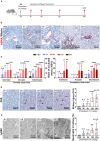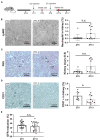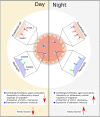Neutrophil circadian rhythm is associated with different outcomes of acute kidney injury due to cholesterol crystal embolism
- PMID: 35966530
- PMCID: PMC9366331
- DOI: 10.3389/fcvm.2022.974759
Neutrophil circadian rhythm is associated with different outcomes of acute kidney injury due to cholesterol crystal embolism
Abstract
Cholesterol crystal (CC) embolism can cause acute tissue infarction and ischemic necrosis via triggering diffuse thrombotic angiopathy occluding arterioles and arteries. Neutrophils contribute to crystal-induced immunothrombosis as well as to ischemic necrosis-related necroinflammation. We speculated that CC embolism-induced acute kidney injury (AKI) would be circadian rhythm-dependent and associated with cyclic differences in neutrophil function. Injection of CC into the left kidney induced thrombotic angiopathy progressing starting as early as 3 h after CC injection followed by a progressive ischemic cortical necrosis and AKI at 24 h. In C57BL/6J mice, circulating CD11b+Ly6G+ neutrophils were higher during the day phase [Zeitgeber time (ZT) 0-12] compared to the dark phase (ZT12-24). In the time frame of thrombus formation at ZT13, more neutrophils were recruited into the injured kidney 24 h later compared to CC embolism at ZT5. This effect was associated with an increased circulating number of CXCR2+ neutrophils as well as an upregulated kidney adhesion molecule and chemokine expression. These findings were associated with a significant increase in kidney necrosis, and endothelial injury at ZT13. Thus, the time of day has an effect also on CC embolism-related AKI in association with the circadian rhythm of neutrophil recruitment.
Keywords: cholesterol crystal embolism (CCE); circadian rhythm; ischemic AKI; neutrophil; thrombosis.
Copyright © 2022 Shi, Zhao, Lyubenov, Motrapu, Li, Steiger, Mammadova-Bach, Yang, Liu and Anders.
Conflict of interest statement
The authors declare that the research was conducted in the absence of any commercial or financial relationships that could be construed as a potential conflict of interest.
Figures






Similar articles
-
Intravenous Glu-plasminogen attenuates cholesterol crystal embolism-induced thrombotic angiopathy, acute kidney injury and kidney infarction.Nephrol Dial Transplant. 2023 Jan 23;38(1):93-105. doi: 10.1093/ndt/gfac273. Nephrol Dial Transplant. 2023. PMID: 36102665
-
Crystal Clots as Therapeutic Target in Cholesterol Crystal Embolism.Circ Res. 2020 Apr 10;126(8):e37-e52. doi: 10.1161/CIRCRESAHA.119.315625. Epub 2020 Feb 24. Circ Res. 2020. PMID: 32089086
-
Both hyperglycemia and hyperuricemia aggravate acute kidney injury during cholesterol embolism syndrome despite opposite effects on kidney infarct size.Kidney Int. 2023 Jul;104(1):139-150. doi: 10.1016/j.kint.2023.03.016. Epub 2023 Mar 30. Kidney Int. 2023. PMID: 37001603
-
Pathophysiology and targeted treatment of cholesterol crystal embolism and the related thrombotic angiopathy.FASEB J. 2023 Oct;37(10):e23179. doi: 10.1096/fj.202301316R. FASEB J. 2023. PMID: 37676696 Review.
-
Clinical Scenarios in Acute Kidney Injury-Parenchymal Acute Kidney Injury - Vascular Diseases.Contrib Nephrol. 2016;188:48-63. doi: 10.1159/000445467. Epub 2016 May 12. Contrib Nephrol. 2016. PMID: 27170038 Review.
Cited by
-
Circadian Effects on Vascular Immunopathologies.Circ Res. 2024 Mar 15;134(6):791-809. doi: 10.1161/CIRCRESAHA.123.323619. Epub 2024 Mar 14. Circ Res. 2024. PMID: 38484032 Free PMC article. Review.
References
LinkOut - more resources
Full Text Sources
Research Materials

